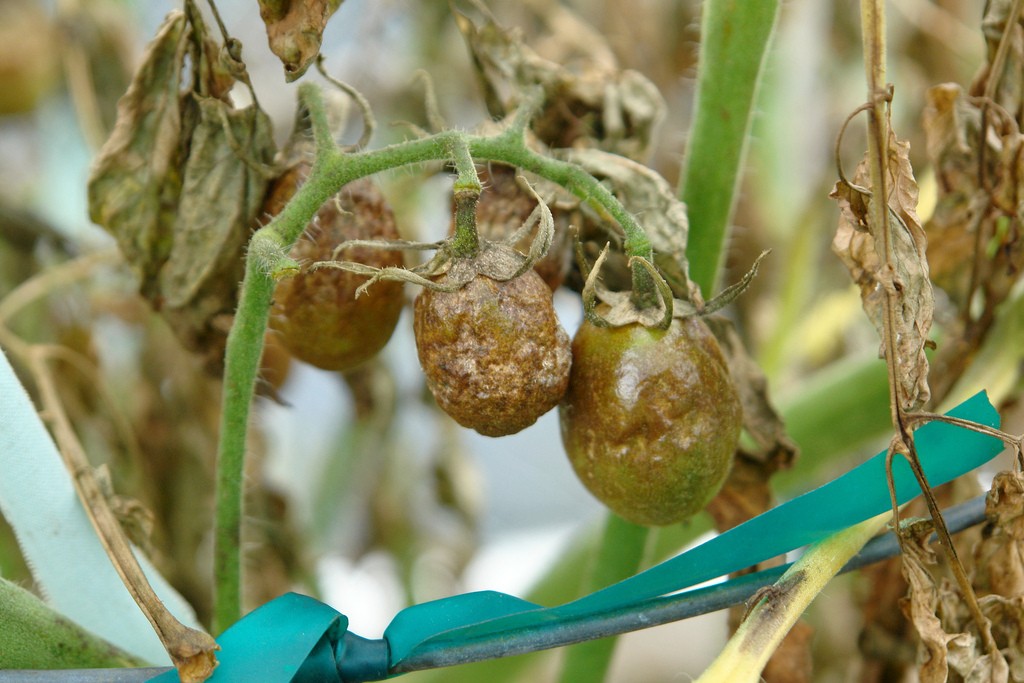Late blight could arrive early

Blight of tomato (Lycopersicon esculentum) caused by Phyophthora infestans. Photo: Scot Nelson, Creative Commons, some rights reserved
The term “blight” strikes fear into the heart of anyone who grows tomatoes and potatoes, but it actually has no strict definition. It can refer to any number of plant diseases, from the innocuous to the truly pernicious. For example, early blight, also known as Alternaria, is a soil-borne pathogen that kills the lower leaves of tomatoes and progresses up the stem throughout the season. Every garden has early blight, and although it is usually not serious, it can be bad in wet years or if a lot of disease spores have built up in the soil.
Late blight, however, is a completely different kind of pathogen. Of all the plant maladies, I think the only one that deserves the fearsome moniker “blight’”is late blight, Phytophthora infestans. Its Latin name, roughly translated, means “highly contagious plant-destroyer.”
Late blight is airborne, so you cannot protect against it through crop rotation and other management practices the way you can with early blight and other garden-variety (so to speak) diseases. It affects leaves anywhere on the plant, not just the lower ones. It also infects stems and fruit, and can kill entire stands of tomatoes and potatoes in just a few days.
Weather plays a big role in the spread of this disease, and this year has been, well, the perfect storm for late blight. Sunlight kills late blight spores in less than an hour, but if it’s cloudy they remain viable for days and can travel long distances. Also, late blight needs moisture to germinate—it won’t infect a dry leaf. What have had in abundance this summer? Yeah, clouds and rain.
Late blight does not overwinter in New York, although it could potentially survive on an infected potato tuber. With the exception of that latter scenario, late blight spores get here from the far south on storm fronts. Once here, every infected plant becomes another one of its spore factories and hastens its spread exponentially. This is why it’s so important for gardeners and farmers to destroy infected plants by bagging them up promptly.
Typical symptoms of late blight are large dark watery lesions, similar to lettuce that has been frozen and then thawed, on leaves, and dark brown lesions on stems. Brown, very firm lesions with a “greasy” look and feel will appear on tomatoes. In damp conditions some grayish “fuzz” may grow on the margins of these lesions.
As of late July, late blight has been confirmed in six New York counties, and two in western Vermont. Essentially we are surrounded and the weather continues to favor late blight’s spread. If you think you may have it, don’t destroy your plants until you get confirmation. Bring a sample of leaves, and fruit if it’s tomatoes, to your Cornell Cooperative Extension office for diagnosis.
To protect tomatoes and potatoes, organic growers can use copper-based sprays to protect their plants, and home gardeners can use products containing chlorothalonil. Neither of these will cure late blight or even halt its spread, but are only meant to protect against initial infection.
Commercial growers with a pesticide applicator’s license can buy products which do stop late blight. Chuck Bornt of Cornell’s Eastern New York Commercial Hort Program advises commercial growers:
“Once you see LB [late blight] on your farm or if you’re downwind of a farm that has LB, use the systemic or translaminar products such as Curzate + Previcur Flex (or other material) + a protectant. Tank-mix Curzate and Previcur Flex because Curzate has a short residual (especially in hot weather), but very good “burn out “activity. Adding Previcur Flex or another labeled translaminar material will greatly improve control. Because of resistance issues with Ridomil, I would wait until the strain has been identified before using it, although so far this year most of the LB strains identified have not been resistant to Ridomil.”
For daily updates on late blight, visit http://www.usablight.org/
PESTICIDE DISCLAIMER: Every effort has been made to provide correct, complete and up-to-date pesticide recommendations. Nevertheless, changes in pesticide regulations occur constantly, human errors are still possible. These recommendations are not a substitute for pesticide labeling. Please read the label before applying any pesticide and follow the directions exactly.
Paul Hetzler is a horticulture and natural resources educator with Cornell Cooperative Extension of St. Lawrence County.
Tags: gardening, late blight, pests







